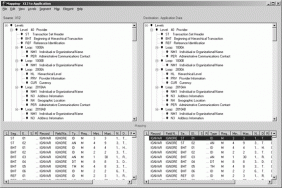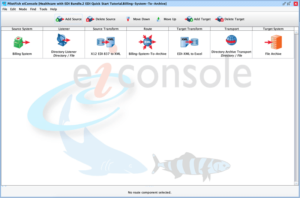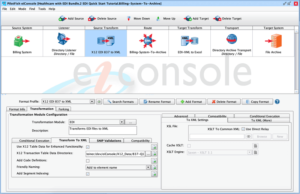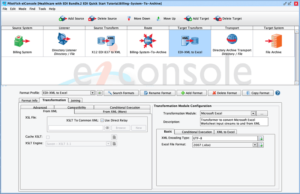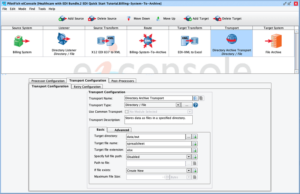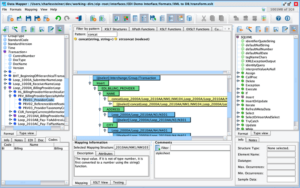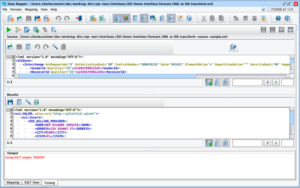PilotFish Software – The Logical Alternative to ECMap
In 2018, Sybase announced end-of-life support for ECMap standalone products. This announcement left thousands of dependent users with tough EOL decisions. With continued use of ECMap, security and operating systems patches, bug fixes and upgrades automatically stop leading to hardware support and maintenance risk – not to mention all the potential legal and regulatory liability risks. Continuing use of ECMap also means shifting resources and incurring costs to maintain the software past its EOL.
Fortunately, there is an ECMap alternative that offers an easy transition: PilotFish’s eiConsole for X12 EDI. The eiConsole for X12 EDI excels over ECMap – in every area. It provides a far superior user interface and offers more features and functionality that boost productivity. Its ease of use allows developers to build, manage and maintain EDI interfaces faster than they ever could with ECMap. It also opens up EDI development to business analysts and non-developers for significant resource savings.
Let’s look in detail at how ECMap compares with PilotFish’s eiConsole for X12 EDI.
Platform Dependency & Performance
ECMap is heavily Windows dependent and uses lots of behind the scenes MS Access database files for data storage and execution – this dependency has a known negative impact on performance. ECMap limits support to Oracle, SQL Server, or Sybase’s database, and support is commercial-only.
PilotFish is system and platform agnostic. Users have the flexibility to work in Mac, Windows and Linux environments and PilotFish is also able to connect to any open-source or commercially-licensed database. Click here for a complete list of PilotFish Product Specifications.
Graphical UI and Configuration
ECMap, while not being quite proprietary, requires that aspects of design, deployment, and management be done through the ECMap UI. However, as ECMap was designed for Windows 98, it is a legacy product and could only be considered to be graphical in the simplest sense of the word.
PilotFish offers a feature-rich suite of integrated components with a fully graphical Integrated Development Environment (IDE). PilotFish users have the advantage of following an automated graphical interface assembly line. No matter how complex or simple the interface, the same visual process can be followed, every time. In the PilotFish IDE, interfaces are developed via configuration (no coding or scripting is required).
Simple configuration screens, with recommended default settings, make these exceptionally fast and are easy to fill out. Drop-down menus offer one-click access to hundreds of built-in adapters. These adapters include connectors that listen for and transport data, processors that perform operations on the data stream and format readers that allow you to instantly read in data. All these adapters can be configured in seconds and provide eiConsole for X12 EDI users tremendous productivity benefits.
Data Format Support
ECMap does most of the data transformation process under-the-hood. There is no ability to extend ECMap or add to the software itself. When a new version of HL7 or EDI, etc. comes out, the user has been wholly reliant on ECMap to integrate support for these into the product.
PilotFish has a strong advantage here. PilotFish’s architecture makes it infinitely extensible with Open Source components where users have the choice of using an Open API or .Net bridge.
ECMap can read in record definitions from Cobol Copybooks, XML of a very specific structure, or from an ODBC database, but these do not come built-in. With ECMap, users must define the entire HL7 or EDI format themselves and then they can export it for use in another map.
PilotFish, in contrast, provides built-in Transformation Modules that are highly automated. Users of the eiConsole for X12 EDI have the ability to use the actual specifications from X12 or HL7 (or others) or you can define your own formats. PilotFish also goes beyond just supporting HL7, EDI and NCPDP and offers built-in format readers to read in a long list of other formats including:
- HL7 3.x
- FHIR
- CCD / CDA
- Positional Flat Files
- Delimited Files (CSV, Custom)
- Key / Value
- XLS / XLSX
- DICOM
- XML
- JSON
- Zip
- Semi-Structured Text
- Binary (.wav, .jpg)
Inter-System Communication
ECMap works by taking incoming EDI and mapping it, but if you want to transmit the results anywhere besides a database, you have to license their separate product, EC Gateway. EC Gateway handles the transport part of the integration workflow. It has its own separate design that requires THREE different databases, each with its own configuration to operate properly. It is also only meant to transport EDI data between two defined trading partners.
PilotFish takes an entirely different approach to communicating with other systems. PilotFish offers B2B Adapters. These are B2B Adapters or Listeners and B2B Adapters or Transport Components which allow you to connect to any Source or Target system or service regardless of what communication protocol is required. Dozens of these built-in connectors are included with the product with no separate license fees. Users also have the ability to add their own connectors, again, using an Open API or .Net bridge. To use these connectors, users follow the same configuration approach as with the other PilotFish components. A drop-down menu for listeners or transports lists the built-in options. Once selected, a custom configuration panel for each type opens and presents the user with recommended default settings for instant ease of configuration.
In addition to the Listener and Transport Adapters, PilotFish also bundles in over 140 Data Processors at no additional license fee. Processors are a mechanism to do general work over the data stream. This is done either directly after it is received or immediately before it is sent. They perform operations that affect all of the incoming data, and these may be layered in any order. PilotFish Processors range from A to Z – Asymmetric Decryption Processor to Zip Decompress.
Data Mapping
ECMap takes a rule-based approach to data mapping. While ECMap provides graphical views for all their different mapping components, doing anything more complicated than mapping field-to-field requires a complex rule setup. In ECMap – every segment has an IO rule (where to read from), a before rule (any rules to apply before mapping the value), an after rule which gets applied after the value mapping, and rules to define which segment to go to next. These rules can be exported for use in other mappings but they’re so specific to the fields, format structure, etc. that, they offer little real value.
ECMap consists basically of two tables containing fields, source and target. You need to define rules for each field you want to map. Everything from field length, data type, etc. has to be defined by hand with these rules. For each transaction type (such as an 834, 837, etc.), the maps contain thousands of these rules. It can take hours just to change or update a single one. With ECMap, each trading partner also has to have their own mapping to handle any business level edits that are required.
Data Mapping Overview – ECMap
An interesting anecdote has been reported by one ECMap user online. According to this user, it’s easier to just use MS Access over the ECMap mapper to do the mappings, since in ECMap all the mapping configuration is stored as MS Access files behind the scenes. The ECMap user stated it was a lot easier to reverse engineer the tables ECMap was storing these mappings in and update them with Access than it was to use the ECMap tool!
PilotFish takes a radically more efficient, modern and user-friendly approach. Following its graphical approach to integration, data mapping is also performed graphically using an exclusive three-pane data mapper. In the eiConsole’s Data Mapper, the source is in the left pane, the target is on the right and the mapping is the middle pane. In PilotFish’s Data Mapper, relating Source formats to Target formats is accomplished by simply dragging the corresponding fields from the Source and the Target panes into the middle pane. (Note: this offers a particular advantage when the Source and Target have repeating or recursive elements.)
PilotFish 3-Pane Data Mapper
Unlike ECMap where the user needs to rely on writing scripts, PilotFish’s Data Mapper includes built-in format builders. These allow users to instantly read in not just EDI and HL7 but also include:
- XSD Format Builder
- Flat File Format Builder
- XML Format Builder
- HTML Format Builder
- SQLXML Format Builder
- WSDL Format Builder
Unlike ECMap, the PilotFish Data Mapping component can read in HL7 v2.x, HL7 v3.0, HL7 Version 3 Reference Information Model (RIM), CDA and HIPAA. It is also the only data mapping tool used extensively in the insurance industry that can read both the ACORD XSD’s and the ACORD Metadata.
The PilotFish Data Mapping component also has special handling for the many XML and EDI standards in use including: DTCC, FIXML, FpML, HR-XML, IFX, OFX, SWIFT, XBRL, and others. It can read both the OpenTravel XSD and the associated Metadata. It is also the only data mapping tool that can read both the HR-XML XSD and the HR-XML Metadata, which are used in Human Resources. PilotFish’s unique industry-specific capability is crucial to enabling many of the time-saving features found within the Data Mapper and one of the reasons Standards Organizations have formed partnerships with PilotFish, including X12.
A Future-Proof Investment
ECMap, owned by Sybase was absorbed into SAP in 2010. The last update to the non-SAP version of the ECMap software was in 2004. ECMap product documentation lists OS support as: Windows 2000, Windows Server 2003, and Windows XP. In 2018, Sybase announced End-of-Life for ECMap standalone products. ECMap users are now forced to weigh the risks and calculate the added costs inherent in continuing to use a product that has reached its end of life.
PilotFish offers a future-proof investment. It is built in Java and has been specifically architected to easily support new standards and technologies as they are adopted. It uses W3C standard technology to ensure you are not locked into a vendor and that your investment is future-proof. As a select distribution partner of X12 and with access to its metadata and artifacts, PilotFish has been able to develop the most full-featured and in-depth support for X12 EDI standards of any product on the market. With a user base of thousands, PilotFish is a proven technology with a dedicated following.
Take a look at some of the productivity-enhancing features valued by PilotFish customers. Proven ease-of-use allows non-developers to do up to 90% of configuration work.
Routing Stages Overview
Data Source Transformation Stage
Data Target Transformation Stage
Data File Destination Options
Drag & Drop 3-Pane Data Mapper
Interface Route Testing & Validation
Detailed Test Data of Route at any Stage
While it might not have seemed like good news at the time, Sybase’s EOL announcement might actually be a blessing in disguise.
Here are RESOURCES to further inform decision-making and support for moving to PilotFish now.
ECMap vs. PilotFish Show & Tell
Detailed side-by-side comparison of ECMAP’s manual processes vs. PilotFish’s automated processes and efficiencies, freeing up your precious IT resources!
10 Easy Steps to Building an X12 EDI Interface
Graphically configure X12 EDI interfaces without any coding or scripting. Use a step-by-step, assembly line process that optimizes implementation speed, consistency, and reuse. Saves money and time!
Let’s start a dialogue today about how PilotFish software can fill your ECMap gap and map out a migration path. We invite you to take a Test Drive and download a FREE 90-Day Trial of the PilotFish eiConsole for X12 EDI.
For more information please call us at 813 864 8662 or click the link below to email us.
HL7 is the registered trademark of Health Level Seven International. X12, chartered by the American National Standards Institute for more than 35 years, develops and maintains EDI standards and XML schemas.

